Results 1 to 1 of 1
Thread Information
Users Browsing this Thread
There are currently 1 users browsing this thread. (0 members and 1 guests)
-
12-08-2014, 10:00 AM #1Banned

- Join Date
- Jun 2013
- Posts
- 8,546
21 Photos of Pearl Harbor and a Day That Will Live in Infamy
December 7, 1941
21 Photos of Pearl Harbor and a Day That Will Live in Infamy
Kelsey Harris December 07, 2014
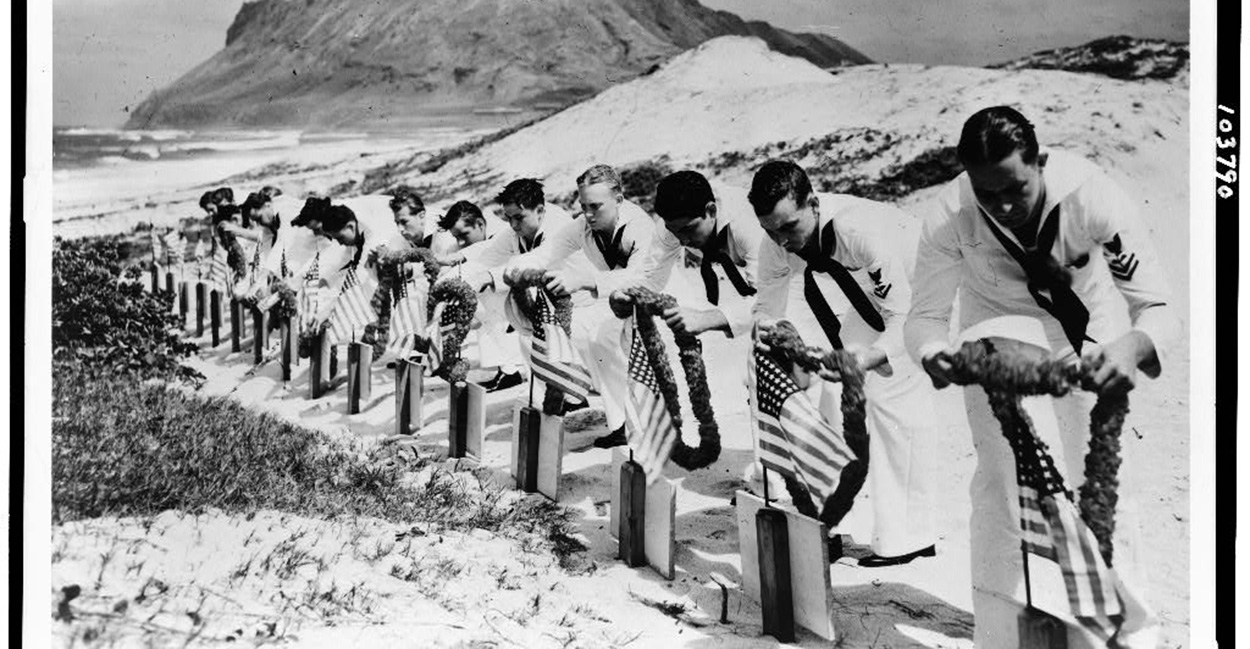
Seamen at Kaneohe Naval Air Station decorate the graves of their fellow sailors killed at Pearl Harbor. (Photo: Library of Congress Prints and Photographs)
Seventy-three years ago today, on Dec. 7, 1941, the Imperial Japanese Navy attacked the U.S. naval base at Pearl Harbor, Hawaii, an act that plunged the nation into World War II. The surprise attack that Sunday lasted less than two hours but killed more than 2,500, wounded about 1,000 and ruined 318 American ships and airplanes. Today we honor the lives lost and remember the terrible day that, in President Franklin D. Roosevelt’s words, will “live in infamy.”
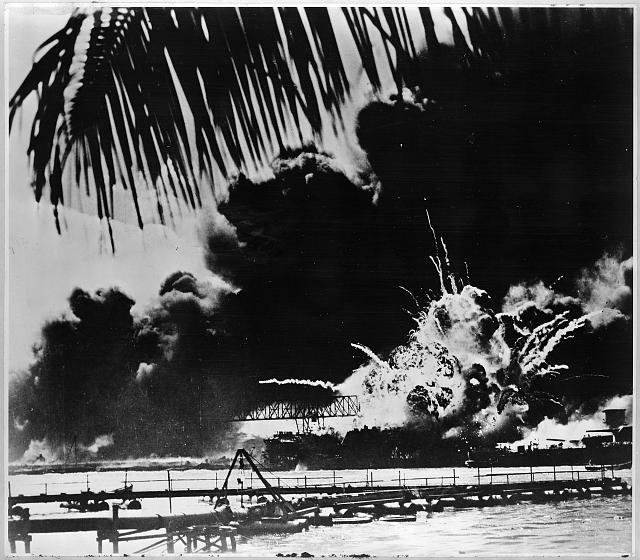 The USS Shaw ablaze after the Japanese attack on Pearl Harbor. (Photo: Library of Congress Prints and Photographs)
The USS Shaw ablaze after the Japanese attack on Pearl Harbor. (Photo: Library of Congress Prints and Photographs)
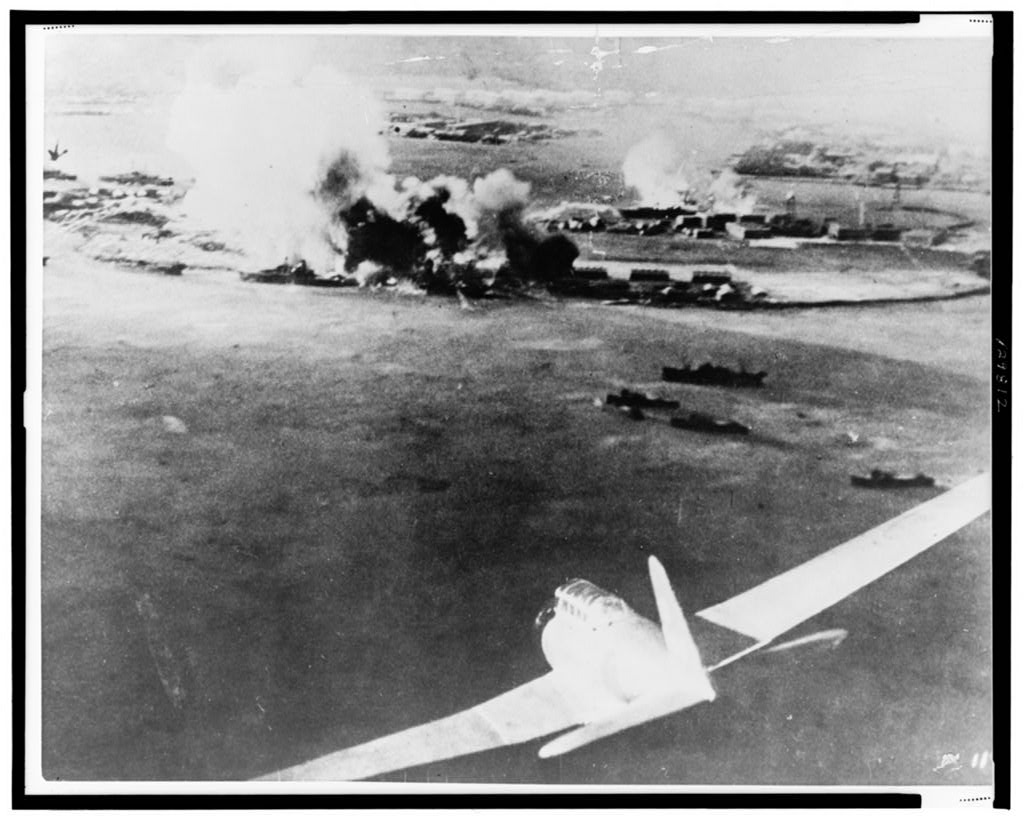 A Japanese pilot took this photo of the bombardment. A Japanese bomber is in the foreground. (Photo: Library of Congress Prints and Photographs)
A Japanese pilot took this photo of the bombardment. A Japanese bomber is in the foreground. (Photo: Library of Congress Prints and Photographs)
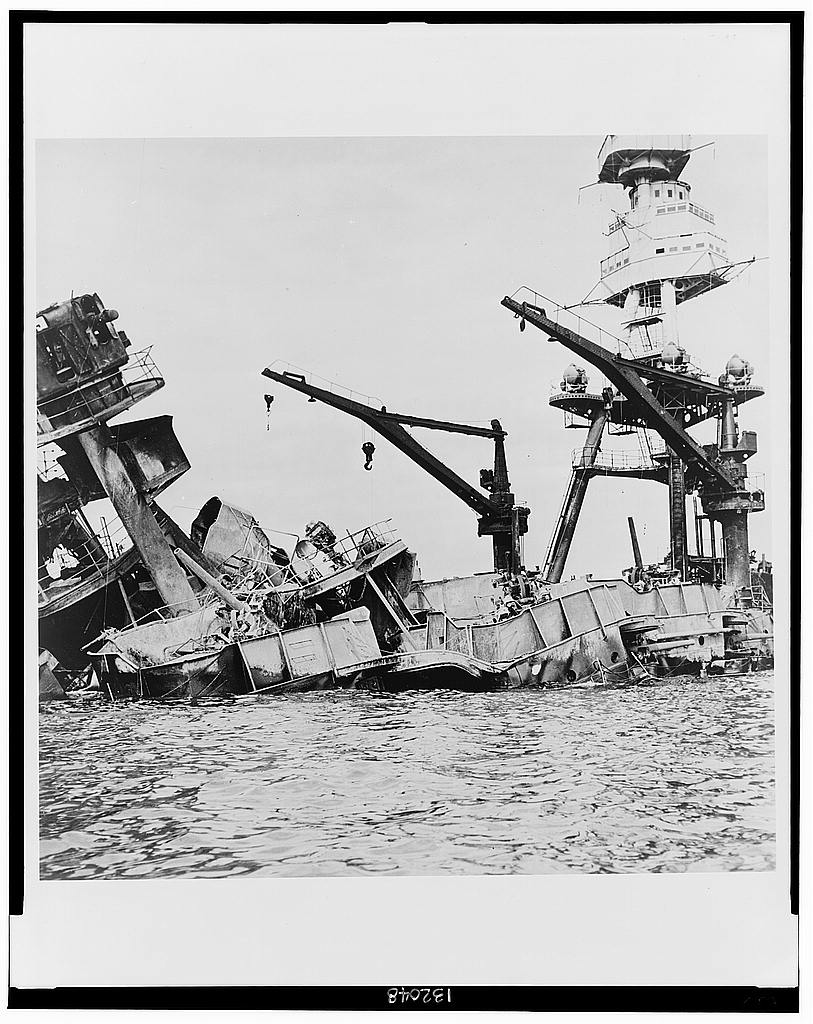 Wreckage of the USS Arizona. (Photo: Library of Congress Prints and Photographs)
Wreckage of the USS Arizona. (Photo: Library of Congress Prints and Photographs)
 An explosion seen from Hickam Field, where 189 were killed and 303 wounded amid extensive damage and loss of aircraft. (Photo: Newscom)
An explosion seen from Hickam Field, where 189 were killed and 303 wounded amid extensive damage and loss of aircraft. (Photo: Newscom)
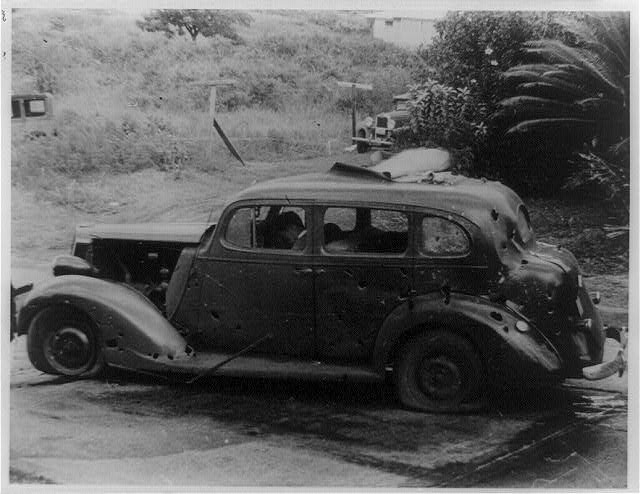 Eight miles from Pearl Harbor, three civilians died in this shrapnel-riddled car after a Japanese plane dropped a bomb. (Photo: Library of Congress Prints and Photographs)
Eight miles from Pearl Harbor, three civilians died in this shrapnel-riddled car after a Japanese plane dropped a bomb. (Photo: Library of Congress Prints and Photographs)
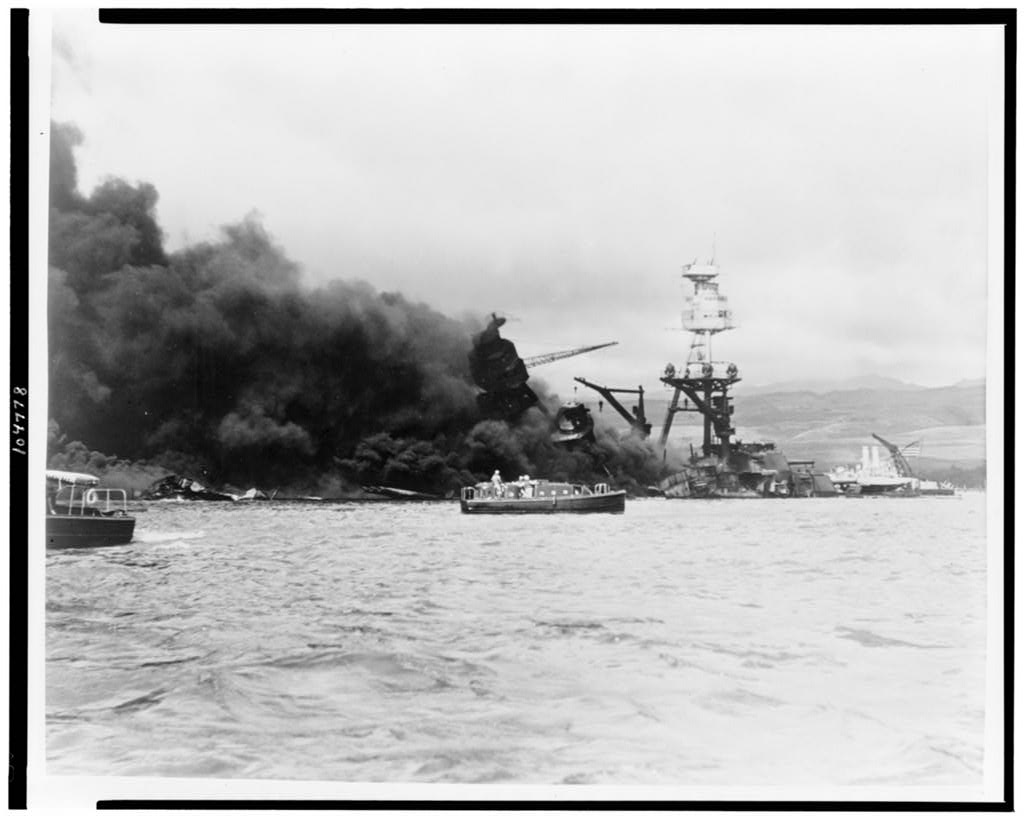 Smoke billows from the USS Arizona during the height of the fire. (Photo: Library of Congress Prints and Photographs)
Smoke billows from the USS Arizona during the height of the fire. (Photo: Library of Congress Prints and Photographs)
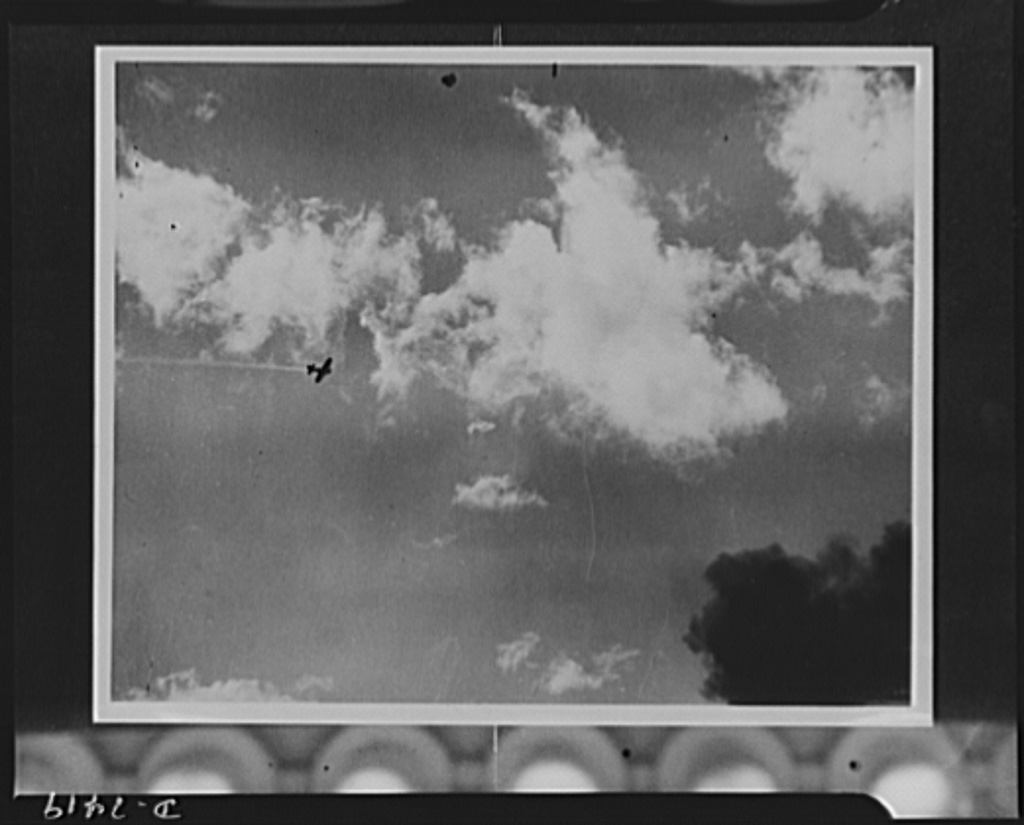 A Japanese bomber, a thin line of smoke trailing in its wake, after being struck by anti-aircraft fire. (Photo: Library of Congress Prints and Photographs)
A Japanese bomber, a thin line of smoke trailing in its wake, after being struck by anti-aircraft fire. (Photo: Library of Congress Prints and Photographs)
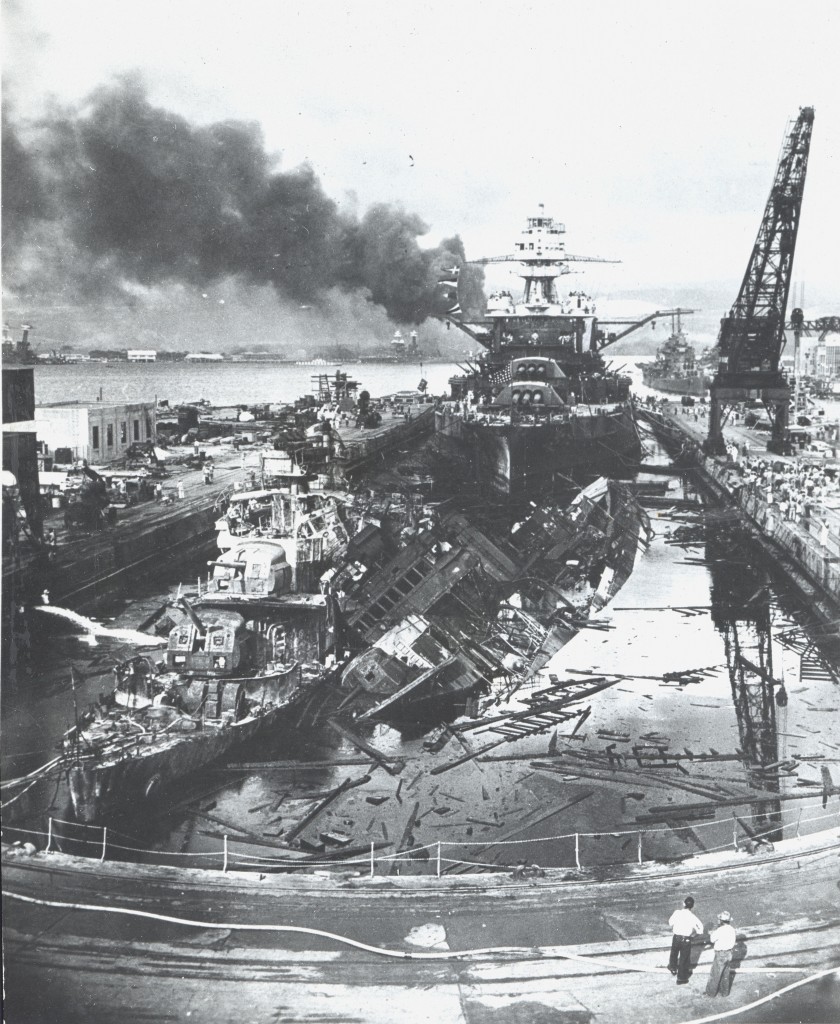 Some of the destruction after attacks by Japanese pilots. (Photo: Newscom)
Some of the destruction after attacks by Japanese pilots. (Photo: Newscom)
 Japanese kamikaze, or suicide, pilots that were organized and used in the war in the latter half of 1944. (Photo: Keystone Pictures/Newscom)
Japanese kamikaze, or suicide, pilots that were organized and used in the war in the latter half of 1944. (Photo: Keystone Pictures/Newscom)
 After being severely damaged and beached, the USS Nevada makes ready to leave her Hawaiian anchorage for permanent repairs elsewhere. (Photo: Library of Congress Prints and Photographs)
After being severely damaged and beached, the USS Nevada makes ready to leave her Hawaiian anchorage for permanent repairs elsewhere. (Photo: Library of Congress Prints and Photographs)
 One of 80 Navy planes wrecked by Japanese bombs and bullets, this is an OS2U — an Observation Scout built by Vought-Sikorsky. (Photo: Library of Congress Prints and Photographs)
One of 80 Navy planes wrecked by Japanese bombs and bullets, this is an OS2U — an Observation Scout built by Vought-Sikorsky. (Photo: Library of Congress Prints and Photographs)
 Inspectors survey what is left of an aircraft at Hickam Field. (Photo: Newscom)
Inspectors survey what is left of an aircraft at Hickam Field. (Photo: Newscom)
 Ships burn in Pearl Harbor. (Photo: Newscom)
Ships burn in Pearl Harbor. (Photo: Newscom)
 This captured photograph was taken aboard a Japanese carrier before the attack. (Photo: Newscom)
This captured photograph was taken aboard a Japanese carrier before the attack. (Photo: Newscom)
 President Franklin D. Roosevelt makes his first radio address to the nation since the attack. (Photo: CSU Archives/Newscom)
President Franklin D. Roosevelt makes his first radio address to the nation since the attack. (Photo: CSU Archives/Newscom)
 The USS Neosho, a Navy oil tanker, backs away from her berth (right center) in a successful effort to escape the attack. At left, the battleship USS California lists after aerial blows. Other crippled warships and part of the hull of the capsized USS Oklahoma are visible in the background. The Neosho later was sunk in the Coral Sea. (Photo: Library of Congress Prints and Photographs)
The USS Neosho, a Navy oil tanker, backs away from her berth (right center) in a successful effort to escape the attack. At left, the battleship USS California lists after aerial blows. Other crippled warships and part of the hull of the capsized USS Oklahoma are visible in the background. The Neosho later was sunk in the Coral Sea. (Photo: Library of Congress Prints and Photographs)
 The USS Oklahoma lies capsized in the harbor. (Photo: Library of Congress Prints and Photographs)
The USS Oklahoma lies capsized in the harbor. (Photo: Library of Congress Prints and Photographs)
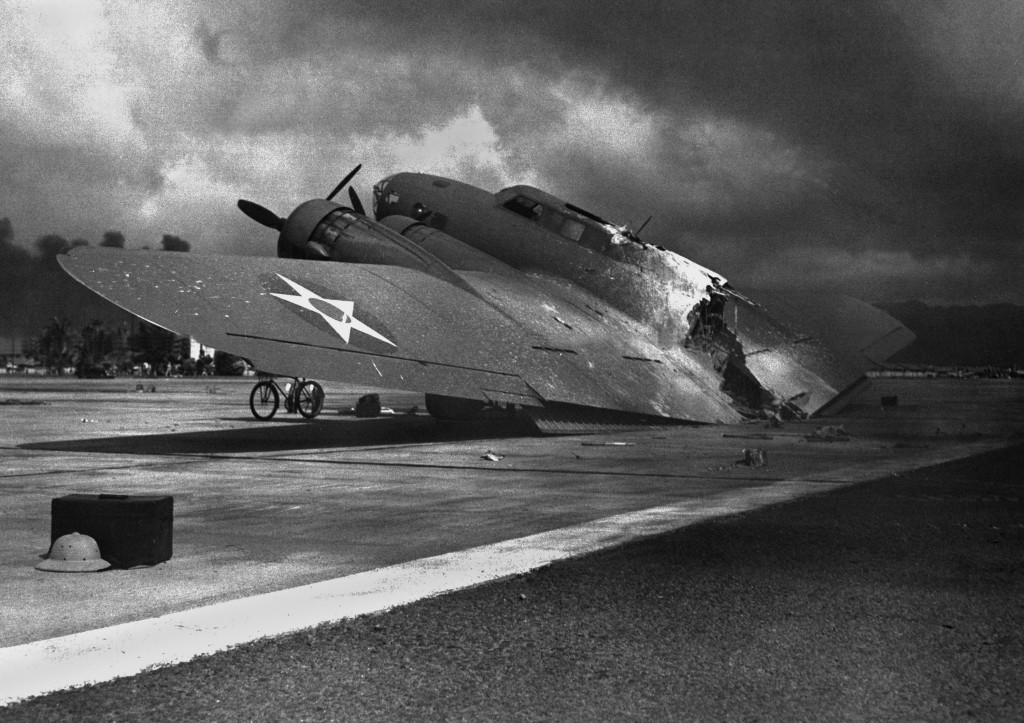 Ruins of a B-17C rest near Hickam Field. Nearly half of about 60 airplanes at Hickam were destroyed or severely damaged. (Photo: Newscom)
Ruins of a B-17C rest near Hickam Field. Nearly half of about 60 airplanes at Hickam were destroyed or severely damaged. (Photo: Newscom)
 The day after: A San Francisco newspaper stand on the morning of Monday, Dec. 8, 1941. (Photo: Newscom)
The day after: A San Francisco newspaper stand on the morning of Monday, Dec. 8, 1941. (Photo: Newscom)
 A U.S. Navy tug raises one of eight Japanese ‘midget subs’ from Pearl Harbor. It was among five Ko-hyoteki-class submarines that entered the harbor; one torpedoed the USS West Virginia. (Photo: Newscom)
A U.S. Navy tug raises one of eight Japanese ‘midget subs’ from Pearl Harbor. It was among five Ko-hyoteki-class submarines that entered the harbor; one torpedoed the USS West Virginia. (Photo: Newscom)
 @KelsRenHar
@KelsRenHar
Kelsey Harris
Kelsey Harris is the visual editor at The Daily Signal and digital media associate at The Heritage Foundation. Send an email to Kelsey.

December 6, 2014 3:00 AM
The Forgotten ‘Pearl Harbor’
The deadly attack didn’t stop the first SEALs from performing a daring rescue. By Patrick K. O’Donnell

An OSS Maritime Unit combat diver trains with a rebreathing device.
Americans remember December 7 as Pearl Harbor Day, but most Americans have never even heard of the “Little Pearl Harbor,” which occurred in Bari Harbor, Italy, on December 2, 1943. More than 100 Luftwaffe bombers mounted a surprise attack on Allied ships moored in the harbor. Their bombs sank or rendered inoperable 28 of these ships. Nearly a thousand Allied troops were killed or wounded. along with hundreds of civilians.
Unbeknownst to those in the port, one of the ships carried liquid death in its belly. The American freighter John Harvey was secretly carrying mustard agent, in violation of international agreements that banned its use. President Franklin Roosevelt had covertly ordered the shipment of 100 tons of mustard agent to Italy for retaliation in the event that the Germans used chemical warfare against the Allied troops. The incident was covered up and remained a secret for decades.
When the German bombs hit the John Harvey, the ship’s hold immediately exploded with devastating violence, killing all those who knew about the mustard. Deadly liquid and gas flew high into the air and then slowly settled back down into the harbor, coating everything and everyone in the vicinity. Casualties would mount over the coming days and weeks as the agent slowly and painfully claimed the lives of many who had survived the initial attack.Among those who survived in the harbor that day were some of America’s first SEALs, the men of the OSS Maritime Unit. Their ranks included Jack Taylor, a former dentist from Hollywood, and Sterling Hayden, one of Hollywood’s leading men. Their stories are captured for the first time in a new book titled First SEALs: The Untold Story of the Forging of America’s Most Elite Unit.
Hayden recalled the drama: “We were trapped on the end of a dock, and eighty partisans from Yugoslavia went right on with what they were doing in spite of the commotion, loading ammunition, blankets, and high-octane gas into a pair of wooden schooners. The leader of the Yugoslavs, a man named Stipanovitch, fired at the low-flying German planes with a machine pistol. ‘Bloody ****ing buggers!’ he yelled over and over again in a deep voice that boomed through a broad mustache.”
Fortunately for the OSS, the Luftwaffe bombers targeted the Allies’ more impressive warships and failed to sink the Maritime Unit’s ragtag fleet, which included a former fishing vessel known as the Yankee. As the OSS men cleaned up Bari and attempted to save civilians and seamen alike from the damage caused by the bombs and the lethal mustard gas, they also prepared the Yankee for one of the most daring and dangerous rescue missions of World War II.
A couple of weeks earlier, a C-53 Skytrooper transport plane carrying 26 American nurses and medics had crashed behind enemy lines in German-controlled Albania. That war-torn country was occupied by the Germans, but it also held a variety of armed insurgent groups and militias who were fighting the Germans. In a high-profile operation authorized by President Roosevelt himself, the first SEALs would attempt to rescue the American medical personnel.
The OSS pioneered modern irregular warfare. It developed the first versions of capabilities and technology that American special-operations forces use today –everything from a rebreather (a precursor to SCUBA) to silent floating mattresses to submersibles to facemasks. More importantly, the OSS men were masters of militias: They were able to organize, train, and control groups of partisans and irregular troops behind the lines. These activities were eerie precursors of today’s world, where the militia has become the king of the modern battlefield, asserting itself in places like Iraq, the Horn of Africa, and Ukraine.
In addition, the OSS developed cultural awareness, often employing archaeologists and anthropologists as operatives who work with the native population. One man summed up the ideal OSS operative perfectly: “A Ph.D. who could win a bar fight.”
The first SEALs successfully infiltrated one of their own into Albania. He worked hand in hand with the British and the local militias to find the nurses and medics and guide them back to the coast, avoiding numerous hostile groups along the way. Linking back up with Hayden and Taylor on the Yankee, the group made another perilous journey through the enemy-infested waters of the Adriatic before finally arriving safely back in Italy.
The nurses and medics weren’t the only ones saved in the aftermath of the attack on Bari. The Allies sent a team of medical investigators to examine the deadly effects of the mustard gas, and they made a startling discovery: Mustard gas could be used to suppress the growth of cancer cells. This discovery was instrumental in the development of chemotherapy that helped to save thousands of lives.
As old becomes new once again, the men of the Maritime Unit are more relevant than ever today. The capabilities and technology they pioneered — maximizing irregular forces and blending special operations with intelligence gathering — have culminated in the execution of the Bin Laden raid and numerous other crucial operations on the modern battlefield.
— Patrick K. O’Donnell is the best-selling author of nine books, including First SEALs: The Untold Story of the Forging of America’s Most Elite Unit, Dog Company, and We Were One, which was selected for the Commandant’s Professional Reading List. He has provided historical consultation for DreamWorks’ award-winning miniseries Band of Brothers; he served as a combat historian with a Marine rifle platoon during the battle of Fallujah; and he is an expert on special operations, Iraq, and counterinsurgency on the modern battlefield. More information is available at PatrickKODonnell.com and FirstSealsBook.com.
http://www.nationalreview.com/articl...ick-k-odonnell
Pearl Harbor
video at link below
 Play video
Play video
Just before 8 a.m. on December 7, 1941, hundreds of Japanese fighter planes attacked the American naval base at Pearl Harbor near Honolulu, Hawaii. The barrage lasted just two hours, but it was devastating: The Japanese managed to destroy nearly 20 American naval vessels, including eight enormous battleships, and almost 200 airplanes. More than 2,000 Americans soldiers and sailors died in the attack, and another 1,000 were wounded. The day after the assault, President Franklin D. Roosevelt asked Congress to declare war on Japan; Congress approved his declaration with just one dissenting vote. Three days later, Japanese allies Germany and Italy also declared war on the United States, and again Congress reciprocated. More than two years into the conflict, America had finally joined World War II.
-
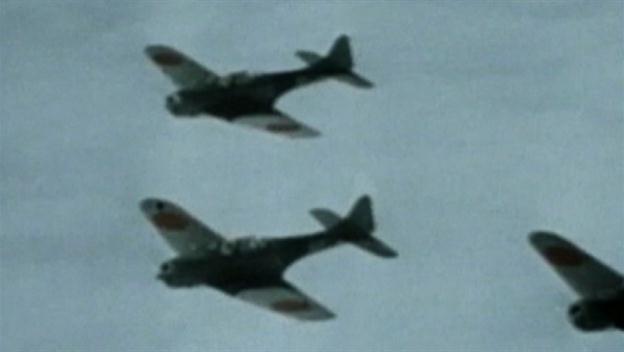 Play video USS Arizona Under Attack at Pearl Harbor 3min
Play video USS Arizona Under Attack at Pearl Harbor 3min
-
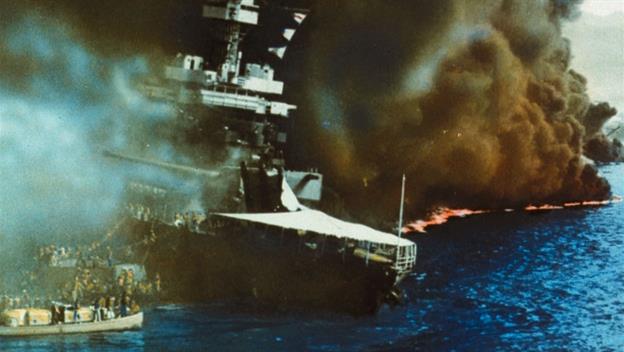 Play video Japanese Attack Pearl Harbor 2min
Play video Japanese Attack Pearl Harbor 2min
-
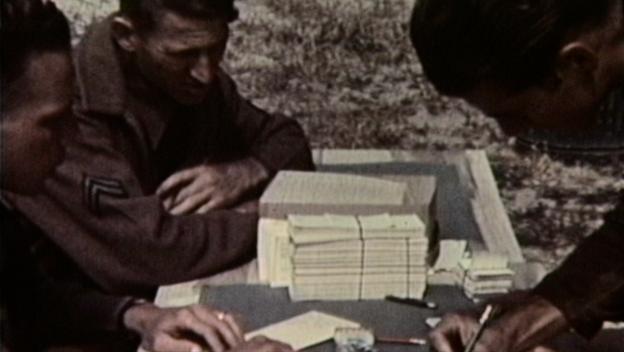 Play video America Enters World War II 5min
Play video America Enters World War II 5min
Pearl Harbor and the Road to War
The attack on Pearl Harbor was a surprise, but Japan and the United States had been edging toward war for decades. The United States was particularly unhappy with Japan’s increasingly belligerent attitude toward China. The Japanese government believed that the only way to solve its economic and demographic problems was to expand into its neighbor’s territory and take over its import market; to this end, Japan had declared war on China in 1937. American officials responded to this aggression with a battery of economic sanctions and trade embargoes. They reasoned that without access to money and goods, and especially essential supplies like oil, Japan would have to rein in its expansionism. Instead, the sanctions made the Japanese more determined to stand their ground. During months of negotiations between Tokyo and Washington, D.C., neither side would budge. It seemed that war was inevitable.
Did You Know?
The single vote against Congress's declaration of war against Japan came from Representative Jeannette Rankin of Montana. Rankin was a pacifist who had also voted against the American entrance into World War I. "As a woman," she said, "I can’t go to war, and I refuse to send anyone else."
But no one believed that the Japanese would start that war with an attack on American territory. For one thing, it would be terribly inconvenient: Hawaii and Japan were about 4,000 miles apart. For another, American intelligence officials were confident that any Japanese attack would take place in one of the (relatively) nearby European colonies in the South Pacific: the Dutch East Indies, for instance, or Singapore or Indochina. Because American military leaders were not expecting an attack so close to home, the naval facilities at Pearl Harbor were relatively undefended. Almost the entire Pacific Fleet was moored around Ford Island in the harbor, and hundreds of airplanes were squeezed onto adjacent airfields. To the Japanese, Pearl Harbor was an irresistible target.
“A Date Which Will Live in Infamy”
The Japanese plan was simple: Destroy the Pacific Fleet. That way, the Americans would not be able to fight back as Japan’s armed forces spread across the South Pacific. On December 7, after months of planning and practice, the Japanese launched their attack.
At about 8 a.m., Japanese planes filled the sky over Pearl Harbor. Bombs and bullets rained onto the vessels moored below. At 8:10, a 1,800-pound bomb smashed through the deck of the battleship USS Arizona and landed in her forward ammunition magazine. The ship exploded and sank with more than 1,000 men trapped inside. Next, torpedoes pierced the shell of the battleship USS Oklahoma. With 400 sailors aboard, the Oklahoma lost her balance, rolled onto her side and slipped underwater. By the time the attack was over, every battleship in Pearl Harbor–USS Arizona, USS Oklahoma, USS California, USS West Virginia, USS Utah, USS Maryland, USS Pennsylvania, USS Tennessee and USS Nevada–had sustained significant damage. (All but USS Arizona and USS Utah were eventually salvaged and repaired.)
In all, the Japanese attack on Pearl Harbor crippled or destroyed 18 American ships and nearly 300 airplanes. Dry docks and airfields were likewise destroyed. Most important, almost 2,500 men were killed and another 1,000 were wounded.
But the Japanese had failed to cripple the Pacific Fleet. By the 1940s, battleships were no longer the most important naval vessel: Aircraft carriers were, and as it happened, all of the Pacific Fleet’s carriers were away from the base on December 7. (Some had returned to the mainland and others were delivering planes to troops on Midway and Wake Islands.) Moreover, the Pearl Harbor assault had left the base’s most vital onshore facilities–oil storage depots, repair shops, shipyards and submarine docks–intact. As a result, the U.S. Navy was able to rebound relatively quickly from the attack.
Pearl Harbor Awakens the “Sleeping Giant”
“Yesterday,” President Roosevelt said on December 8, “the United States of America was suddenly and deliberately attacked.” He went on to say, “No matter now long it may take us to overcome this premeditated invasion, the American people in their righteous might will win through to absolute victory. I believe I interpret the will of the Congress and of the people when I assert that we will not only defend ourselves to the uttermost, but will make very certain that this form of treachery shall never endanger us again.” After the Pearl Harbor attack, and for the first time after years of discussion and debate, the American people were united in their determination to go to war. The Japanese had wanted to goad the United States into an agreement to lift the economic sanctions against them; instead, they had pushed their adversary into a global conflict that ultimately resulted in Japan’s first occupation by a foreign power.
On December 8, Congress approved Roosevelt’s declaration of war. Three days later, Japanese allies Germany and Italy declared war against the United States. For the second time, Congress reciprocated. More than two years after the start of the conflict, the United States had entered World War II.
http://www.history.com/topics/world-war-ii/pearl-harbor
also some past posts
- Pearl Harbor Day Dec 7, 1941 I will never forget will you???
By kathyet in forum Other Topics News and Issues
Replies: 1 Last Post: 12-07-2010, 09:50 AM - Today is Pearl Harbor Day!!!
By kathyet in forum Other Topics News and Issues
Replies: 3 Last Post: 12-07-2009, 01:20 PM
- Remembering Pearl Harbor
By loservillelabor in forum Other Topics News and Issues
Replies: 3 Last Post: 12-07-2006, 03:30 PM
“December 7, 1941 – a day that will live in infamy.” We remember those who fought to protect our country at Pearl Harbor and throughout all of WWII.

Sorry I am a day late bringing this over..
- Remembering Pearl Harbor
Last edited by kathyet2; 12-08-2014 at 01:29 PM.
Similar Threads
-
Pearl Harbor Day Dec 7, 1941 I will never forget will you???
By kathyet in forum Other Topics News and IssuesReplies: 1Last Post: 12-07-2010, 12:50 PM -
Today is Pearl Harbor Day!!!
By kathyet in forum Other Topics News and IssuesReplies: 3Last Post: 12-07-2009, 04:20 PM -
Buffett: U.S. in Economic Pearl Harbor
By AirborneSapper7 in forum Other Topics News and IssuesReplies: 1Last Post: 01-20-2009, 09:10 PM -
U.S. discovers 'Pearl Harbor II' plot
By jp_48504 in forum Other Topics News and IssuesReplies: 3Last Post: 09-12-2007, 03:39 AM -
Remembering Pearl Harbor
By loservillelabor in forum Other Topics News and IssuesReplies: 3Last Post: 12-07-2006, 06:30 PM


 LinkBack URL
LinkBack URL About LinkBacks
About LinkBacks




 Reply With Quote
Reply With Quote

PHOTOS: Biden’s Released Migrants Still Camp on Streets of El...
05-04-2024, 04:01 PM in illegal immigration News Stories & Reports